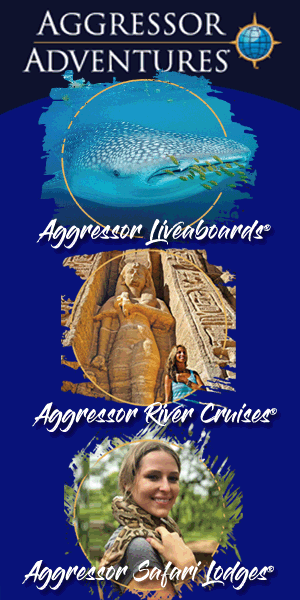Every destination has its marquee attraction — something that immediately comes to mind. When we think of the Turks and Caicos Islands, that attraction is the miles and miles of white-sand beaches. Our first visit to the island chain had us strolling for hours along the shoreline, enjoying sunsets, sunrises and views of the clear-blue waters. This island nation also boasts some terrific wall diving. Add easy access from the United States and you’ve got yourself a diving vacation with all the right ingredients.
History and Geography
The Turks and Caicos chain, southeast of the Bahamas and north of Haiti, consists of eight major islands and about 30 additional islands and cays. The name is believed to have originated from the Turk’s Head fez cactus and the Carib word “caya hico,” meaning string of islands. The Caicos Islands are composed of West Caicos, Providenciales (“Provo”), North Caicos, Middle Caicos, East Caicos and South Caicos. The Turks Islands are Grand Turk and Salt Cay. The islands are sparsely populated with the majority of tourist development on Providenciales along Grace Bay.
The first inhabitants of the chain of islands were the Lucayan Indians who boasted a highly developed culture with their own language, government, religion and trade routes. Columbus is believed to have been the first white man to make landfall in 1492 and with his arrival came the eventual demise of the Indian nation, as inhabitants were forced into slavery or suffered from European-borne diseases.
Over the next few centuries, ownership of the islands bounced between the French, Spanish and British, ending finally with Great Britain. The islands were virtually uninhabited until 1678 when a group of Bermudans settled on Salt Cay and began extracting salt and logging trees. The salinas or salt-drying pans still exist on Salt Cay as well as many of the other islands. At one time, Salt Cay was the world’s largest producer of salt. Today it still waits for its first asphalt road. The majority of the salt was exported to New England and the east coast of Canada for the cod-fishing industries. If you’ve ever tasted salt cod you understand the requirement for the enormous amounts of salt.
In 1799 the archipelago became a formal part of the Bahamas but in 1848 it became self-governing under the guidance of the governor of Jamaica. Jamaica annexed the islands in 1872 and this tie to Jamaica continued until 1962 when they were again linked to the Bahamas. In 1973 the Turks and Caicos became a separate crown colony of Great Britain.
Until the late 1980s, the islands remained quiet and secluded. With the opening of a Club Med on Provo the tourist industry began to boom. Today Provo is the most developed and tourist oriented of all the islands, with many resorts on the popular sandy beach of Grace Bay.
So Many Islands to Choose From
The islands of the Turks and Caicos offer diversity that appeals to almost any type of vacation. For those looking for more entertainment and nightlife, stay in the main tourist center of Providenciales; for those seeking a quiet getaway, try the islands of North or Middle Caicos; for some historic adventure and even more isolation, visit the capital island of Grand Turk.
Providenciales
Entry and exit to the country is through the international airport on Provo. One of the key historic attractions here is Cheshire Hall. This 200-year-old ruin of a cotton plantation offers some spectacular views of Provo.
A visit to the world’s only commercial Conch Farm is also a must. The farm established in 1984 offers tours of its hatchery where there are about 1.5 million Caribbean queen conch in all stages of development.
Of course, a visit to Provo wouldn’t be complete without a stroll along the 12-mile (19-km) stretch of white sandy beach around Grace Bay. As you enjoy walking in the turquoise-blue waters you may even see one of the national treasures of the islands — JoJo, an Atlantic bottlenose dolphin that has been living and playing in the shallow waters since 1980. He is one of the few dolphins around the world that voluntarily interacts with human beings in his natural habitat. JoJo has his own warden as well as a foundation called the JoJo Project. This project was created to help provide both legal and medical protection for JoJo, including public education and research programs for JoJo and other endangered wildlife.
Provo offers the most variety in accommodations and activities of all the Turks and Caicos. There are a number of resorts and hotels to choose from and you will also have quite a choice of restaurants delivering both international and local cuisine. In addition to the diving, you can try your hand at windsurfing, parasailing, deep-sea fishing, bone fishing and snorkeling.
Grand Turk
Grand Turk is the capital island and the financial center of the Turks and Caicos. Here you will find a selection of historical buildings with a Bermudian flavor as well as the Turks and Caicos National Museum. The museum is most notable for its Molasses Reef Wreck exhibit, the oldest European shipwreck discovered in the Western Hemisphere (dated around 1505).
A major marine attraction in the winter months is the migration of the North Atlantic humpback whales around the islands of Grand Turk and Salt Cay. These incredible creatures pass through the area on their way to the Silver Banks to mate and calf. Snorkeling and whale watching trips can be arranged through several tour operators.
Grand Turk accommodations range from bed-and-breakfast to quaint inns and hotels, many with historical significance. Dining out in Grand Turk ranges from pizza to local cuisine and seafood — certainly something to satisfy anyone’s taste buds.
Middle Caicos
Middle Caicos is the largest of the islands and offers the most dramatic landscapes, with limestone cliffs and never-ending sandy beaches. It is also home to one of the largest cave systems in the Caribbean at Conch Bar Caves National Park. The caves were once a sacred area for the Lucayan Indians, and petroglyphs can still be seen on some of the walls.
From Middle Caicos you can also visit North Caicos via a trail that links the two islands during low tide.
Accommodations and restaurants are limited, with one larger resort and several smaller villas.
South Caicos
South Caicos is the fishing capital of the islands, and features a superb natural harbor. Here there are several fishing plants, which process most of the nation’s seafood harvest of lobster, conch and fish for export and local consumption. The abandoned saltpans also provide habitat for a variety of birds, marking this location as one of the bird watcher’s marquee destinations within the Caribbean.
Diving the Reef and Walls and Walls and Walls
The Turks and Caicos are surrounded by a dramatic reef and wall system that offers excellent year-round visibility. Fore-reefs made up of spur and groove formations start in the shallower depths and run down to a steeply sloping wall beginning at around 50-60 feet (15-18 m). The tops of the reefs are home to an abundance of tropical marine fish and fauna while off the walls you have an excellent chance of seeing some larger pelagics (big open-water fish). The majority of the dive sites can be found along the north and west coastline of Providenciales and West Caicos. But the other islands shouldn’t be ignored. French Cay and Grand Turk offer some pristine reefs that are less well traveled.
On Providenciales some of the more dramatic sites include The Crack, Black Coral Forest and Stairway.
The Crack is a large fissure running in a big arc through the reef. The crack is open at the top, allowing for easy exploration. The fault in the reef begins at about 45 feet (14 m) and empties out onto a wide sandy ledge at 125 feet (38 m). As you travel the crack keep your eyes open for lobster, crab and other small critters in the rocks. On the top of the reef, keep a lookout for some big schools of snapper and grunts.
Black Coral Forest is a section of reef that overhangs the main wall starting in 45 feet (14 m) of water and continuing to an undercut ceiling at 80 feet (24 m) and then dropping off into the deep blue below. This wall is covered with some impressive stands of black coral. The branches of coral are home to schools of fairy basslets and bluehead wrasse.
Stairway is a large trench in the side of the reef that is covered by huge stands of plate corals that cascade down the reef to a depth of about 100 feet (30 m). The large plates form a huge staircase topped with vibrant soft corals and attended by schools of snapper, chub and grunts.
West Caicos is the place to see some of the bigger animals such as reef sharks, spotted eagle rays and turtles. You may even catch sight of a manta ray or hammerhead in the channel between the north point of West Caicos and the outer reef. Along the west side of West Caicos you can enjoy a number of great sites such as Highway to Heaven, White Face and Elephant Ear Canyon.
At French Cay the fish life is abundant with pristine sponges and soft corals covering the tops of the walls. During the winter, French Cay is also a great place to catch sightings of humpback whales. Along the outer edge of the banks is Molasses Reef. At one time these shallow reefs resulted in frequent shipwrecks.
If you are looking for a less traveled location then Grand Turk is definitely it. With just a few hotels on the island, the reefs see very little diver traffic. Grand Turk has a superb wall along the west coast of the island, and it is covered with healthy growths of soft and hard corals. Amphitheater and McDonald’s are two favorites here.
McDonald’s get its name from a beautiful coral arch covered in colorful sponges and hard corals. The arch entrance is at about 30 feet (9 m) and you exit out on the wall at around 60 feet (18 m) with nothing but deep blue below you.
Amphitheater is a sand channel leading to a giant cut in the reef at about 45 feet (14 m). Swim out from the steep slope and you can see the big Amphitheater created by the cut in the reef wall. The wall hosts some very healthy wire coral and gorgonians rising up around you as you swim down through the cut. Up in the sand channel you can find a large colony of garden eels. See how close you can get before they disappear into the sand. The trick is to approach very slowly.
Choose Your Adventure
The Turks and Caicos can certainly offer a huge variety of diving, accommodations and topside activities. From cracks to sand channels to dramatic drop-offs plus large and small marine life, you’ll never be short on options. Just remember to take some time and enjoy those beaches.





